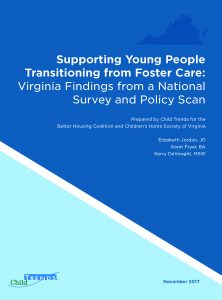 CHS partnered with Better Housing Coalition and ChildTrends to create a report focusing on outcomes for older youth transitioning from foster care. The report was based on a policy scan and a national survey, and analyzes the services that Virginia provides to the transition-age youth population as compared to other states. It sheds a light on areas where stakeholders and state leaders can improve and strengthen specific services.
CHS partnered with Better Housing Coalition and ChildTrends to create a report focusing on outcomes for older youth transitioning from foster care. The report was based on a policy scan and a national survey, and analyzes the services that Virginia provides to the transition-age youth population as compared to other states. It sheds a light on areas where stakeholders and state leaders can improve and strengthen specific services.
Here is what we learned about Virginia:
Virginia’s Strengths
- Virginia extends foster care until age 21 using Title IV-E funds as a result of the implementation of the Fostering Futures program in 2016.
- While not all services are available statewide, there are a wide array of services available in the areas of education, employment, financial capability, housing, health care, and permanency.
- In several areas, transition-age youth in Virginia are faring as well or better than youth with foster care experience nationally.
Virginia’s Challenges
- According to 2014 data, Virginia had one of the highest percentages of youth aging out of foster care in the country.
- The services Virginia offers are not available to all youth statewide, but only in certain counties, especially housing related services.
- Although Virginia reported using some programs based in research, Virginia was generally unaware of whether services being provided were evidence based or research informed. It is important to invest finite public resources in services that have proven to be most effective.
